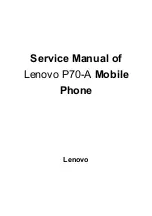
White Paper
T630/T628
34
October 2003
and graphics on a portable device. That is why the
main applications driving Mobile Internet develop-
ment are e-mail clients and WAP browsers.
The demand for high-speed Internet access will be
the key driver for coming generations of wireless
services, and GPRS can deliver the necessary
speed. GPRS allows innovative services to be cre-
ated, enabling new and previously inaccessible
market segments to be addressed and increasing
customer loyalty.
GPRS applications can be developed as both hori-
zontal and vertical. Vertical applications are spe-
cific, including those for operations such as
reaching police and emergency, taxi, delivery or
automated services (vending machines, supervi-
sion, vehicle tracking). Horizontal applications are
more generic and include those for Internet access,
e-mail, messaging, e-commerce and entertain-
ment.
GPRS is able to take advantage of the global cov-
erage of existing GSM networks. Applications
developed for GPRS can be deployed on a large
scale and can reap the associated benefits. GPRS
also provides a secure medium for connections to
private networks, banking and financial services.
With GPRS, the T630/T628 sends data in “pack-
ets” at a very high speed. The T630/T628 remains
connected to the network at all times, using trans-
mission capacity only when data is sent or
received.
Using GPRS in the T630/T628
Instead of occupying an entire voice channel for
the duration of a data session, the T630/T628
sends/receives data in small packets, as needed,
much like IP on the Internet. Because of this, the
T630/T628 maintains a constant online connection,
its data transmission abilities summoned by the
application in use on an as-needed basis.
The GPRS specification includes four coding
schemes – CS1, CS2, CS3 and CS4 – that allow
data speeds of 9,050 bps, 13,400 bps, 15,600 bps
and 21,400 bps respectively. The T630/T628 works
with all four coding schemes, but data speed will
naturally vary according to network configuration.
At the moment, CS-3 and CS-4 are not supported
in any live network, i.e present speed is limited to
53,600 bps.
The GSM system limits the ability to use all eight
time slots, so the T630/T628 uses up to four time
slots for receiving data, and one slot for transmit-
ting. This means the speed for receiving data is up
to 85,600 bps and up to 21,400 bps for sending
data.
Using GPRS with the T630/T628 has several
advantages, for example:
•
Constant connection
•
Keep an open connection to an e-mail system
or the company network, staying online to
receive and send messages at all times. All con-
nection settings can be managed by using the
data connections feature.
•
High speed
•
Gain access automatically to increased band-
width when downloading large files, images etc.
•
Cost efficient
•
Use transmission capacity only when needed,
thus reducing costs.
•
WAP over GPRS
•
Access the Internet via WAP at high speed and
with a constant connection.
•
E-mail over GPRS
•
Remain connected to an e-mail system while
reading and preparing messages, (which are
sent at a high speed).
•
Data communication
•
Transfer data and access the Internet or an
intranet with a PC, PDA or handheld device
connected via Bluetooth wireless technology,
infrared or cable.
•
Data and voice
•
Maintain a data connection, for example, a con-
stant connection to an e-mail system when con-
ducting a voice call.
•
Provide settings
•
Receive GPRS configuration settings from the
provider over the air, OTA, making manual con-
figuration unnecessary.
•
User controlled settings
Содержание T628
Страница 1: ...October 2003 T630 T628 ...
















































